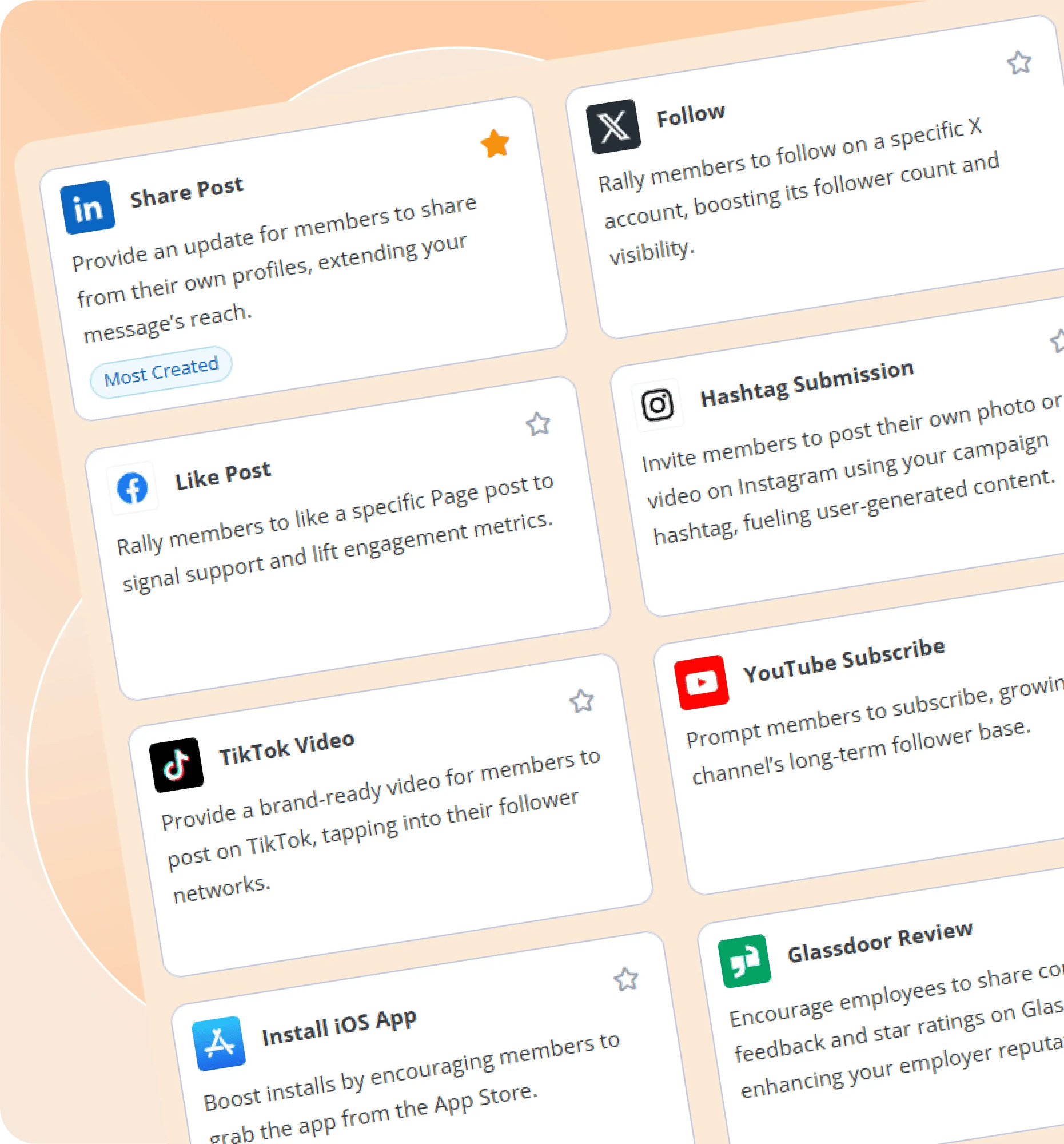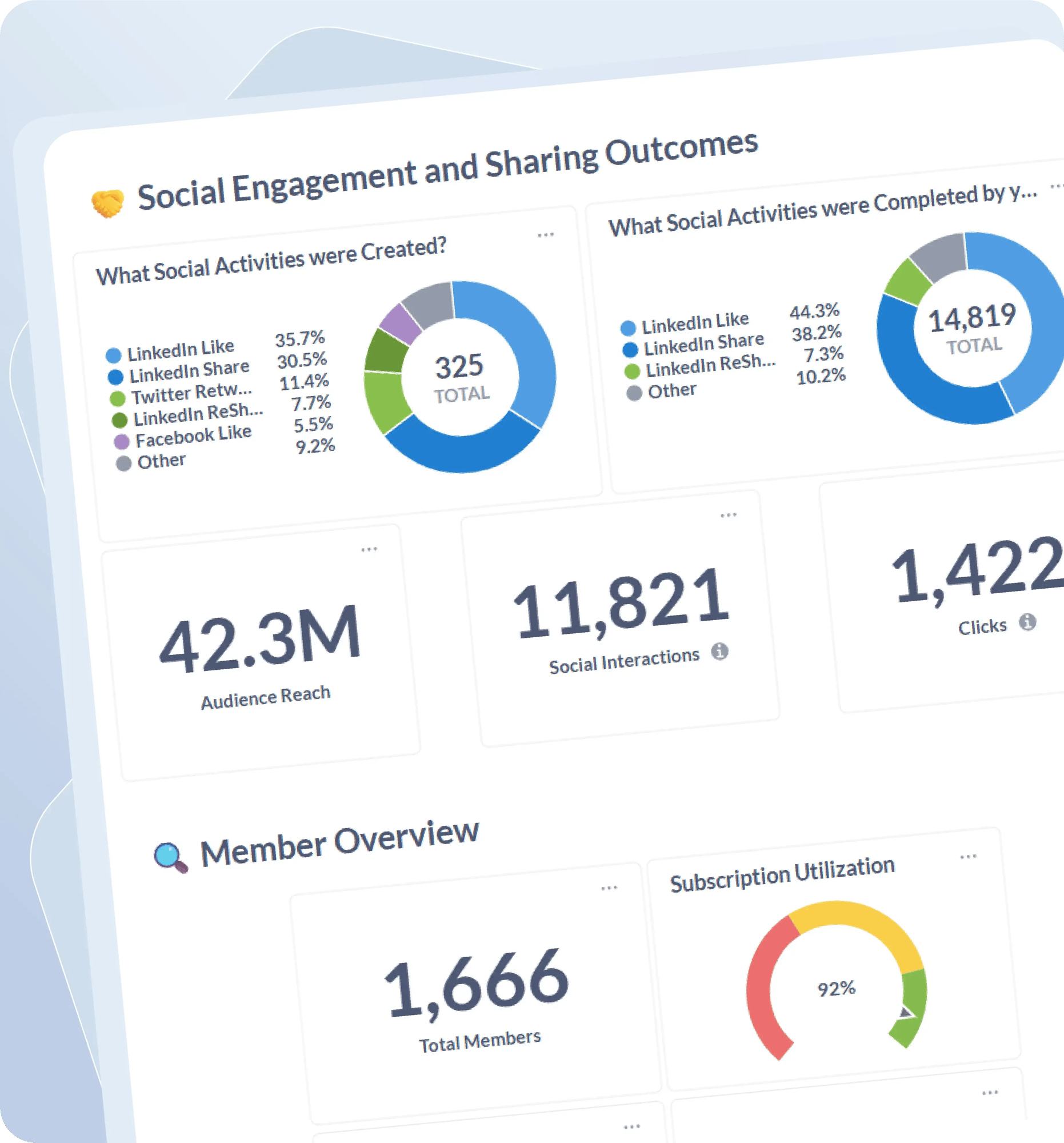
Elevate Your Employer Branding. Build Your Talent Pipeline.
Enable your employees to create and share content about the company, culture, and people, while tapping into their networks to distribute career opportunities at scale.
Trusted and Recommended By





RECRUITING
Recruit and Attract Top Candidates at Scale
When employees share your job openings with their network, they attract talent from your industry and with like-minded connections.
-
Easily share and engage on social media for global recruiting needs.
-
Increase engagement on existing job applications and social media posts.
-
All employees can take part in helping to recruit new talent at your company.

"GaggleAMP is incredibly easy to use for our social team, and even easier for the rest of our organization to help boost our brand awareness efforts via social. We've leveraged the custom redemption options to drive even more engagement and reach for our messaging."

Sara Ajemian
Director, Corporate MarketingENABLEMENT
Promote a Culture of Sharing and Engagement
Reduce turnover and boost employee satisfaction by emphasizing what your employees love about your company.
-
One-click employee engagement on company content to amplify reach to their social audience.
-
Drive a stronger internal community that showcases work culture and helps distributed teams get to know one another.
-
Help your team enhance their own personal networks while lowering hiring costs and increasing brand trust.

DEMONSTRATE ROI
Track Performance & Measure Your Audience Reach
Empowering employees to post about their work experiences is one of the best ways to build your employer branding profile and generate trust for both future hires and customers. Track the performance of your social media posts and create more of what resonates with your audience and less of what doesn't.

Real Customers. Real Results.
$2M
WGroup's sales pipeline built using GaggleAMP's employee advocacy platform.
31%
Magna5 drives 8% of the company's total sales pipeline using GaggleAMP to increase brand reach and awareness.
6mo
Contrast Security employees saw over 13K new connections to their personal social accounts in under 9 months.
Elevate Your Employer Brand. Build Your Talent Pipeline.
There are countless brands on the market today. We know many of these brands because of successful branding. But branding is not a one-size-fits-all marketing approach.
There are many different types of branding, including employer branding. While businesses must focus on branding their company to attract potential customers and business growth, it is also essential for companies to focus on their brand as an employer.
Employer branding is how companies market themselves to job seekers, helping secure top talent. A company has a reputation that is established with their internal workforce, industry, and potential candidates. When a company’s reputation is positive, a benefit of employer branding includes retention and attracting potential new employees.
This reputation exists if a company has intentionally attempted to craft it or not. Therefore, it is critical for a business to understand what its reputation is and intentionally take steps to craft an employer brand that accurately reflects its company’s values and culture.
An internal employer branding strategy establishes the internal company culture based on the brand story and how employees carry out brand values internally and externally. Employer branding and talent management are cohesive in attracting and retaining the best talent.
Human resources and talent acquisition often go hand-in-hand. Typically an HR department works with a third-party recruiting company, or an internal recruiting department. Understanding what is employer branding in HR is crucial for establishing strong, positive company branding internally and externally.
Human resource departments operate as the face of the company. New employees receive their first impression of company culture with HR, and existing employees see HR as the face of the company for many years to come. HR plays a significant role in company branding through an employee's tenure with a company and beyond. HR often supports employees through transitions, including layoffs or career transitions to other companies.
An internal employer branding strategy is a significant part of an employer branding strategy. Internal branding connects current, active employees with a company's external brand. Internal branding is a philosophy that communicates a company's culture, identity, and premise to employees and consumers. The effort aims to empower employees to operate as company ambassadors, representing the company and its values inside and outside the organization, or on and off the clock. A company with a strong internal branding strategy clearly defines its values and missions to its employees.
Additionally, internal branding requires active engagement at all levels of the organization. Ensuring employee engagement is vital for internal branding. Visual branding is an integral part of external branding; incorporating a visual branding strategy internally is also important. Internal and external branding must be related, allowing employees to see the connection between the internal and external brands. Employer branding is an essential part of company culture for current and future employees and plays a crucial role in employee retention.
Employer Branding Strategy
An employer branding strategy is a plan that companies establish to influence how employees internally and externally perceive their brand. The goal of creating an employer branding strategy is to allow a company to control the narrative about its practices as an employer to help acquire and retain the best talent in its industry. An effective employer branding framework can positively impact every facet of the business, including talent acquisition, employee retention, optimizing performance, and maximizing profitability.
Employer branding activities include planning and defining a clear employer branding strategy and then implementing the strategy with existing employees and talent acquisition departments. Another method includes creating an attractive career site for those seeking employment.
Branding activities include social media engagement to share employee testimonials and success stories and utilizing popular job boards like LinkedIn Jobs or Indeed by creating attractive, advanced profiles. In addition, employee branding activities can extend to in-person events such as local career fairs and recruiting opportunities at colleges and universities.
Companies with good employer branding, like Google, communicate that the organization is a good employer that creates a positive workplace. Starbucks is another excellent example of strong employee branding. They are globally recognized and well-known for having a positive company culture that promotes employee engagement, longevity, and support for career goals inside and outside the organization. Starbucks is one of the best employer branding companies with a strong social media presence that clearly establishes its company culture and creates a positive online community for employees. Company reputation matters because most employees will only apply to work for (or want to continue to work for) a company with a good reputation.
Employer Branding in Recruitment
An employer brand is a perception current, and potential employees, have about a company. Employer branding initiatives include intentionally establishing company values, work culture, and public persona, ensuring they align with potential candidates' and current employees’ aspirations. Understanding what is the role of employer branding in recruitment is essential because employer branding plays a significant role in recruitment and retention for a company. And understanding what is employer branding in recruitment is essential for HR departments and talent acquisition, too, so they can effectively recruit the right candidates for their company.
Employer branding in recruitment is not about misleading people. Instead, it is about clearly defining a company's unique employee value proposition. In other words, what unique benefits are offered to employees in return for their talent and experience?
Talent recruitment is a form of marketing. Examples of employer branding in recruitment include communicating the employer brand accurately so top talent can understand what a company is about internally and externally.
Today, many companies conduct marketing efforts through social media platforms. As with sales marketing, recruitment marketing involves employer branding. For example, LinkedIn employer branding includes:
-
Interacting consistently online.
-
Creating attractive career pages.
-
Posting job listings.
-
Providing valuable content to help those searching for jobs in your industry.
Today's job market is highly competitive, and a positive employee brand is vital for attracting and retaining top talent.
Branding requires a strong storytelling element. Through employer branding companies must be able to honestly and creatively express how they want their organization to be perceived in the marketplace. More than that, the story told when establishing a brand must be consistent with existing company culture so current employees will stand by the external branding portrayed by the company. Internal and external employee branding must align to be effective.
Why Is Employer Branding Important
Why is employer branding important when so many people are seeking employment opportunities? In short, the importance of employer branding rests in the ability to hire new employees, retain employees, establish a strong company culture, and potentially reduce costs and increase revenue—employer branding matters.
Employer branding activities in recruitment are how companies market their company to those seeking employment. To attract and retain top talent, employer branding is vital. The best employer branding examples showcase an organization's uniqueness and positive elements.
The digital age has empowered job seekers to find information and gain an inside perspective into potential employers more than ever before. Establishing employer branding images and the correct verbiage is critical in establishing a consistent employer branding strategy. Images drive social media, and social media drives reputation. Employer branding must include a social media and image aspect. Two of the best employer branding social media examples include Google and Starbucks. Both companies have excellent, consistent reputations for being great places to work based on employer branding success.
Employer branding is a concept that is gaining momentum in the digital age. An employer branding model includes defining and promoting a company as an employer of choice through well-defined aspects of company culture and image. Employer branding examples on LinkedIn include establishing a company as an attractive choice for top talent in their specific industry. Employer branding models include internal and external branding, attracting talent, and increasing retention for existing employees. An intentional effort to establish an employer branding model includes eight elements of a successful employee brand. The eight elements of a successful employment brand include:
-
Establishing a culture of sharing and a commitment to continuous improvement.
-
A healthy balance between high productivity and good management.
-
An effort to gain recognition as a great place to work.
-
Word of mouth from employees about being a great place to work.
-
Obtaining positive press about being a great place to work.
-
Gaining status as a benchmark firm.
-
Promoting awareness to employment candidates.
-
Establishing branding metrics.
Employer branding platforms such as LinkedIn, Indeed, or various social media outlets play a significant role in establishing an employer brand among top talent. Promoting different types of employer branding such as work culture and perks, open job positions, and employee spotlights makes excellent content for employer branding platforms. Developing an employer branding model that works is critical for employers today.
One of the many benefits of employer branding includes attracting top talent. In addition, effective employer branding can decrease the time and cost required for each new hire. Even more, benefits include boosting employee morale for existing employees and increased retention.
Employers with a strong, positive reputation through employer branding also build credibility and trust with customers. Positive company culture is enhanced with an intentional effort to establish employee branding. In addition, employees who work in a positive company culture for companies with a strong reputation inside and outside the company are more engaged and have increased employee satisfaction.
